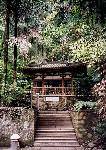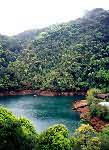- Getting around Lijiang. Dont stay in the Old Towns more than 2 days, there is nothing to do. KRISS Oct 9, 2013 05:46
- 2013 Beijing Temple Fair BENNYLAU Feb 26, 2013 03:29
- Malaysian traveling from KUL - LAX vis Shanghai PVG ZATI_DY Jan 3, 2013 20:15
<A> An Ancient Land
- Views: 5465
- |Vote: 2 0
- |Add to Favorites
- |Recommend to Friends
Part 1
It took three and a half hours to reach this place. Yet when we got here, everything was covered in a light drizzle and a white misty veil. At first glance, Zhaoqing is like any southern Chinese city, bustling with commercial activity, skyscrapers announcing every major Chinese bank and securities firm in bright neon, billboards featuring the latest handphones, electric scooters and Yao Ming staring angrily at a basketball in his hands. We checked into the Star Lake Hotel, once known and loathed as the tallest building in Zhaoqing, but now dwarfed by many nearby buildings taller and more imposing than itself. On the way up the bubble lift, the bellhop informed us that on a clear day, we could see well beyond the Star Lake at the verdant, rolling mountains of Guangxi. We looked out, and all we could see was rain and fog.
We spent the rest of a wet day just wandering the nearby streets, picking out bargains in the form of quaint antiques, local produce and inkstones, something Duanzhou (a district of Zhaoqing province) is rightly famous for. Legend has it that China's wisest and most respected judge, Bao Zheng, who had served a term of office here in Zhaoqing, had tried to leave with an inkstone secretly left in his bag by a grateful villager. The weather turned nasty and the water became too rough to travel. When Bao Zheng realised the truth, he threw it overboard without second thought. Immediately, the weather calmed and he was able to leave. Stories of his brilliance, wisdom and incorruptibility remain to this very day.
The next morning, the fog had lifted enough for us to feel that this won't be another wasted day. We drove 20 minutes to Mount Dinghu, the premier natural attraction of Guangdong and Guangxi, and a UN-designated bio-scientific research station to boot. On the way up, the guide waxed lyrical about Bao Zheng, and his contributions to Zhaoqing while he was here. The man's name seemed to crop up everywhere in Zhaoqing, in conversations, guidebooks, and even daily newspapers. I couldn't understand why such a modern people would be so intensely proud of such a historical figure, instead of boasting about their GDP or impressive annual growth estimates. I simply couldn't understand their obsession, and put it down to a lack of real history in this particular area of China.
Mt Dinghu is a place of great natural beauty. It is filled with ancient foliage, hanging waterfalls of breathtaking scale, and flora and fauna to captivate the most jaded of naturalists. We rode a boat across the 18m deep, emerald green Dinghu Lake, visited the butterfly farm, and trekked through prehistoric jungle. The trek down towards Fei Shui Tan, or Flying Water Pond, was the highlight of my trip. I could imagine a poet writing word upon word about its beauty. I could imagine Justice Bao sitting in one of its mid-air pavilions, nestled in a overhanging cliff, pondering the mysteries of the human psyche while the snow falls silently around him, and a brook gurgles quietly nearby, recuperating after a hard week in court, letting the cold air revive his mind and spirit...enough. I was beginning to think like a Zhaoqing resident.
CONTINUED IN PART 2
Part 2
Zhaoqing used to be surrounded by earthen walls in ancient times. Then, during the Northern Song Dynasty (1118 A.D. to be precise), these were replaced by brick. It is unusual to find city walls in China in any state, much less ones so well preserved as these. For the traveller who has time, this is a good trip to make. Apart from the walls themselves, one can see a lovely wooden, gable-roofed look-out post known as the Pi Yun Tower. Because of its elevation, Pi Yun Tower is often shrouded in cloud, hence its name. Inside the tower, one will find photographs, paintings and calligraphy describing its place in Zhaoqing history. It even has two sets of wax statues, one depicting the Ming Dynasty Emperor Yong Le, and the other Bao Zheng during his tour of inspection of the city walls. Yes, there he is again, his stature given equal billing as that of an Emperor. No wonder some Zhaoqing residents revere him as a god. I knew he was a good man and a wise one, but I was beginning to wonder what the fuss was all about.
On our last day in Zhaoqing City, we made a trip opposite our hotel to the Star Lake, or Xing Hu. Strictly speaking, the Star Lake is made up of 2 separate attractions, Mt Dinghu (18km east of the city) and Qi Xing Yan, or Seven Star Crag. This is basically an area containing seven limestone or Karst formations of stunning beauty, almost rivalling those of Guilin. The lake itself is man-made, much to my disappointment. I didn't like to think I'd come all this way to see a Chinese disneyland. The lake spans an area of 7 sq km and is divided into 5 smaller lakes, each with its own colourful name. All are shallow - less than 3m deep. That rules out large craft with deep hulls, and consequently the lakes are pretty empty of traffic, which is good news for those who don't like their natural scenery spoilt by too much human activity. While we didn't have much time, we did manage to pack in a trip up the Immortal Palm Rock (another 60m of climbing - bring hiking shoes!) and a serene-looking temple right at the top with a clear view right across the lake back to the hotel. If Justice Bao had felt inclined, he could climb up this very rock and spend hours up here isolated from the dust and detritus of humanity. That wouldn't be a bad way to spend a Sunday afternoon.
As I stood up there, looking at the city from afar, I began to understand a little of the Zhaoqing admiration for Bao Zheng. Here was a wise man determined to preserve justice and integrity for his beloved country. And here are a wise people determined to preserve history and culture for their beloved city. At a time when everyone in China is rushing headlong into modernization, when places like Beijing are crushing their lovely old houses to make way for the 2008 Olympics, when Shanghai and Shenzhen are more interested in making money than making art, here was Zhaoqing quietly fusing new with old, embracing new technology yet still remembering how to make inkstones. Who uses brush and ink anymore? Yet, artisans and craftsmen dedicate their whole lives making these anachronistic items for sale, the techniques unchanged since the time of the great Justice Bao. Which city in China can boast this level of ying and yang balance, widely preached but seldom practiced? Perhaps the wisdom of Bao Zheng is what's keeping this city, and its people, alive and well. I had a new respect for Justice Bao.
That afternoon, as we left, the weather took a turn for the worse. Rain pelted down and everything once again retreated behind a gossamer veil. Zhaoqing was bidding us goodbye in her own unique way. I looked at the nasty weather and reached down to touch the inkstone in my bag. No, I didn't throw it out of the bus. But for a moment, I understood what Bao was trying to do. I did not want to take anything from Zhaoqing, the city in which time moves forward yet stands still. I wanted it to remain the way it is, so when I come back again one day, I hope to see it just the way I had left it.





 Copyright © 1998-2025 All rights reserved.
Copyright © 1998-2025 All rights reserved.
1.
Apr 19, 2005 16:56 Reply
MERMAID said:
sorry, 960-1127.
2.
Apr 19, 2005 16:55 Reply
MERMAID said:
Northen Song Dynasty: 907AD to 1127AD